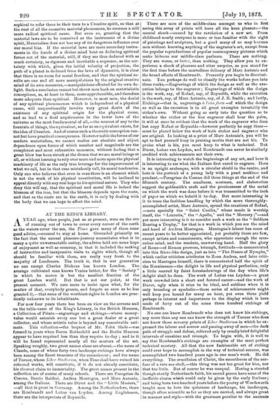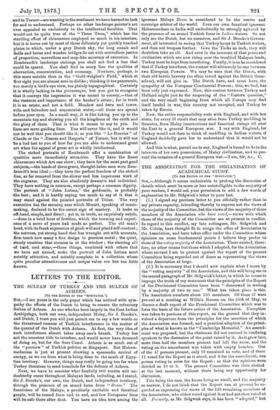AT THE KING'S LIBRARY.
AYEAR ago, when people, just as at present, were on the eve of running out of town to cover every corner of the earth as the waters cover the sea, the Times gave many of them some good advice,—counsel to stay at home. Grounded primarily on the fact that the annual pleasure-journey necessitates what is to many a quite unwarrantable outlay, the advice held out some hope of enjoyment as well as economy, in that it included the making of instructive and inexpensive visits to sights which, though all should be familiar with them, are really very fresh to the majority of Londoners. The truth is, that in our generation no one except Charles Dickens has known London. The average cultivated man knows Venice better, for the " Society " in which he moves is but the smallest fraction of the great London world. But that is not our point, at the present moment. We care more to insist upon what, for the matter of that, everybody grants, and forgets as soon as he has granted it,—that some of the worthiest sights in London are prac- tically unknown to its inhabitants.
For now four years there has been on view on the screens and on the table-cases of the King's Library, in the British Museum, a Collection of Prints—engravings and etchings—whose money- value would astonish every one but a great dealer or a great collector, and whose artistic value is beyond any conceivable esti- mate. This collection—the bequest of Mr. Felix Slade—was formed in years when Baron Rothschild and the Berlin Museum appear to have required less than they require to-day ; and in it will be found represented nearly all the masters of the art. Speaking roughly, two great names alone are absent,—the name of Claude, some of whose forty-two landscape etchings have always been among the finest treasures of the connoisseur ; and the name of Turner, whose Liber Studiorm, when Time shall have ruined his coloured works, will constitute, if it do not already constitute, his clearest claim to immortality. The great names present in the collection are of course of many schools. There are Peregrino da Cesena, Baccio Baldini, Andrea Mantegna, and Marc Antonio, among the Italians. There are Diirer and the "Little Masters," —all that is great in Germany. Among the Netherlanders, there are Rembrandt and Lukas van Leyden. Among Englishmen, there are the interpreters of Reynolds.
There are men of the middle-class amongst us who in first seeing this array of prints will have all the keen pleasure—the mental shock—caused by the revelation of a new art. From childhood nearly everyone is more or less familiar with the sight of paintings and sculpture, but a good many of us may become men without knowing anything of the engraver's art, except from the popular reproductions of popular contemporary pictures which make hideous our middle-class parlours. These are nothing. They are worse, or better, than nothing. They allow you to ex- perience a shock of pleasure and utter surprise, as you stand for the first time before the marvellous delicacy of Marc Antonio and the broad effects of Rembrandt. Presently you begin to discrimi- nate. You perhaps do well to classify the works before you into three ranks,—Engravings of which the design as well as the exe- cution belongs to the engraver ; Engravings of which the design is the work, say, of Rafael, say, of Reynolds, while the execution is the work, say, of Marc Antonio, say, of J. R. Smith ; and lastly, Etchings—that is, engravings a l'eau forte—of which the design as well as the execution is in all great examples invariably the etcher's own. Without going so early into the question as to whether the etcher or the line engraver shall bear the palm, it will at once be evident that the work of the engraver who does but copy Rafael or Reynolds—however perfectly he copy these— must be placed below the work of both etcher and engraver who are original. In looking at a print of Marc Antonio's, you will be apt to find yourself busy in praising merits that are not his. To praise what is his, you must keep to what is technical. But Diirer, Lukas van Leyden, and Rembrandt can never be similarly credited with achievements not their own.
It is interesting to watch the beginnings of any art, and here it is interesting to see what the Italians first cared to engrave. Here is an upright arabesque, with a circular shield in the centre, and here is the portrait of a young lady with a pearl necklace and pendant,—Peregrino da Cesena did these things at the end of the fifteenth century. The smallness, neatness, and elaboration suggest the goldsmith's craft and the preciousness of the metal on which the work was done before it was transmitted to the inch of paper on which we behold it to-day. But more interesting is it to trace the faultless handling by which the more thoroughly- accomplished artist, Marc Antonio, spread the creations of Rafael, —note specially the "Saint Cecilia," whose music is worship itself, the "Lucretia," the "Apollo," and the " Mercury ;"—and yet more interesting is it to consider such a work as the "Soldiers Bearing a Trophy," for that is a work in which you see the mind and hand of Andrea Mantegna. Mantegna's labour has come of recent years to be better appreciated, yet probably there are few, except artists and connoisseurs, who appreciate enough the mas- culine mind, and the resolute, unswerving hand. Half the glory of Rome—of Roman prowess, triumph, fortitude—is concentrated into this frieze-like design, just as into "The Dance of Nymphs," which earlier criticism attributes to Zoan Andrea, and later criti- cism to Mantegna himself, there is concentrated half the spirit of the Renaissance—the delight in life and physical perfection, only a little marred by faint foreshadowings of the day when life's delight shall be done. The work of Lukas van Leyden—a great work crowded into a short and fevered career—and the work of Diirer, ugly when it tries to be ideal, and sublime when it is only brooding or symbolic—these series of achievements might well keep you bound for many an hour, yet even these yield perhaps in interest and importance to the display which is here made of forty out of the some three hundred etchings of Rembrandt.
No one can know Rembrandt who does not know his etchings, any more than any one can know the strength of Turner who does not know those seventy prints of Liber Studiorum in which he ex- pressed the labour and sorrow and passing-away of men—the dark path of struggle and defeat, relieved only by cruelly brief delightful intervals of sunshine and triumph. To begin with, it is well to say that Rembrandt's etchings are examples of the most perfect technical mastery. All that the now fashionable art of etching could ever hope to accomplish in the way of technical success, was accomplished two hundred years ago in one man's work. He did everything. The crucifixion of Christ, the smoothness of the sur- face of a rare sea-shell,—this thing was not too great for him, nor that too little. But of course he was unequal. Having a stunted though sturdy Netherlands faith, his sacred pieces have none of the ineffable charm which could only be given by the early Italians ; and being born two hundred years before the poetry of Wordsworth taught men to love the quietness of landscape, his landscapes, though often scientific as far as they are carried, and always great in manner and style—with the greatness peculiar to the ancients
and to Turner—are wanting in the sentiment we have learned to look for and to understand. Perhaps no other landscape painter's art ever appealed so exclusively to the intellectual faculties. That would not be quite true of the "Three Trees," which has the startling effect of chiaroscuro employed so much in his interiors, but it is borne out by most of those delicately yet quickly touched plates in which, under a grey Dutch sky, the long canals and fields and barns and wooden bridges lie out with marvellous justice of proportion, marvellous and map-like accuracy of execution. In Rembrandt's landscape etchings you shall not find a line that 'could be spared. You shall find in every line the qualities of abstraction, concentration, and economy. Nowhere, perhaps, is this more notable than in the " Gold-weigher's Field," which at first sight you are almost sure to dislike ; thinking it too panoramic, too merely a bird's-eye view, too plainly topographical. Certainly it is wholly lacking in the picturesque, but you get to recognise that it conveys the impression it was meant to convey,—that of the vastness and importance of the banker's estate ; for in truth it is an estate, and not a field. Meadow and barn and tower, villa and belvedere and ornamental water,—all these are spread before your eyes. In a small way, it is like taking you up to the anountain-top and showing you all the kingdoms of the earth and the glory of them. That is what it means to say to you. Its fines are mere guiding lines. You will never like it, and it would amt be well that you should like it, as you like "Le Bouvier" of -Claude or the " /Emma and Hesperia" of Turner, but it will not be a bad test to you of how far you are able to understand great -art when the appeal of great art is wholly intellectual.
The etched portraits of Rembrandt offer a combination of qualities more immediately attractive. They have the finest chiaroscuro which Art can show ; they have for the most part good subjects,—the heads of these grave, thought-laden men were Rem- trandt's true ideal ;—they have the perfect freedom of the etched line, so far removed from the slower and leas impetuous work of the engraver. They are also absolutely dramatic and individual. They have nothing in common, except perhaps a common dignity. The portrait of "John Lutma," the goldsmith, is probably the best ; and it is hardly saying too much to say of it that it may stand against the painted portraits of Titian. The very execution has the seeming ease which Mozart, speaking of music- making, declared to be the surest sign of mastery. It looks so off-hand, simple, and direct ; yet is, in truth, so exquisitely subtle, —done in a brief hour of fruition, which the learning and experi- ence of a score of years had made so perfect. The old man's head, with its frank expression of good-will and placid self-content ; the nervous, yet strong hand that has wrought out with accurate, firm touch how many a fine design in precious metal ; the quiet, steady sunshine that streams in at the window ; the slanting sill of hard, cool stone,—these things, combined with others that we have not named, make the portrait of John Lutma most notably attractive, and notably complete in a collection whose quite peculiar attractiveness and unique value are but too little known.



































 Previous page
Previous page